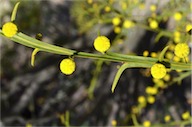Information about plants in flower this week
A news sheet prepared by a Gardens' volunteer, featuring the flowers, fruits and foliage of a selection of plants in
the Australian National Botanic Gardens .
Numbers before each plant refer to temporary IFTW labels in the gardens.
Numbers in square brackets [ ] refer to garden bed Sections. Featured plants are in bold type.
View past issues of 'In Flower This Week'.
3 - 16 August
Today we will walk from the Visitor Information Centre (VIC) up the hill behind the café in search of early-flowering wattles.
- Crowea exalata [Section 221], on your right in a pot as you leave the VIC, forms a mounded bush of fine green foliage with red stems dotted with pink star flowers. Croweas are neat long-blooming additions to any garden. This species is native to Queensland, New South Wales and Victoria.
- Leucopogon attenuatus [Section 174] is further on your right in a pot. A small shrub with white flowers on sparse stems, it occurs in the wild from Queensland to Victoria.
- Bear left up the road behind the café to see on your left Acronychia littoralis [Section 114]. This small tree has shiny green leaves with many clusters of green berries. The Scented Acronychia or Beach Acronychia grows naturally in north eastern coastal New South Wales and a few areas in adjacent Queensland. It is endangered in the wild.
- Bear right along the road behind the Rock Garden to see Acacia amoena [Section 3], or Boomerang Wattle, on your left. It is a small bush with tough yellow-green phyllodes (modified leaf-stalks) and golden balls of flowers. It is native to New South Wales and northern Victorian tablelands.
- Acacia blayana [Section 2] is on your left, with grey-green foliage and bright yellow balls of flowers. It is found only in Wadbilliga National Park near Bega, New South Wales. It is endangered in the wild.
- Acacia 'Purpurea' [Section 3] on your left has many sprays of golden balls of flowers with striking silver-grey fringed foliage with a feathery texture. This showy cultivated variety of Acacia baileyana is very fastgrowing and tough.
- Acacia boormanii [Section 3], or Snowy River Wattle, on your left, has fine needle foliage and masses of golden balls of flowers. It is a medium-sized, suckering, multi-stemmed, copse-forming shrub, with a native range in the alpine country of south eastern Australia.
- Turn left up the hill to see Acacia ulicifolia [Section 18], or Prickly Moses, on your right, with many pale yellow balls of flowers on fine, dark green, prickly foliage. This wattle grows along the eastern part of Australia from Queensland to Tasmania.
- On your left is Acacia oshanesii [Section 3], native to coastal New South Wales and Queensland. This tree has fine dark green divided foliage with some fluffy yellow balls of flowers.
- Acacia decora [Section 1], or Showy Wattle, on your left, has grey-green foliage and large golden balls of flowers. It is common in eastern Australia from Queensland to Victoria.
- Turn left along the edge of the Eucalypt Lawn to see on your left Acacia caesiella [Section 1], from the central slopes of New South Wales. It forms a low spreading bush of grey-green linear foliage with yellow balls of flowers.
- Turn back across the path to your right to see on your right Acacia cardiophylla [Section 18], or West Wyalong Wattle, with ferny light green bipinnate foliage and masses of yellow balls of flowers. It occurs in the wild in central and southern New South Wales.
- Continue over to the main path leading downhill to see Acacia trigonophylla [Section 18] on your far left, which is an interesting wattle with flattened phyllodes and gold balls of flowers blooming on the stem. It is native to southwestern Western Australia.
- On both your left and right is Acacia consobrina [Section 18], native to southwestern Western Australia. It is a low bush with grey foliage and large golden balls of flowers.
- Acacia venulosa [Section 18], further along on your left, has green linear foliage and bright yellow balls of flowers. It is native to northern coastal and tableland areas of New South Wales and south-eastern Queensland, especially in the Stanthorpe area.
Rosalind Walcott
![Director of National Parks [logo]](../../../../images/dnp_90px.gif)







